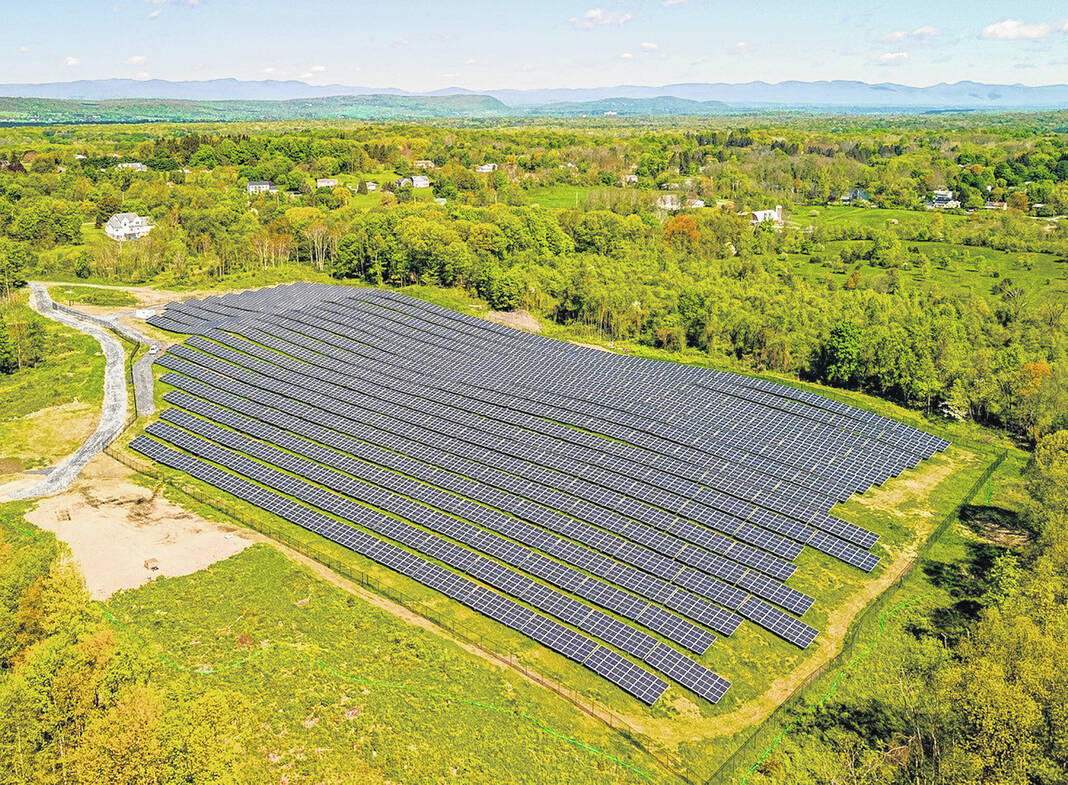
Typical Nexamp community solar projects, like the one pictured here, average 35 to 65 acres.
Provided photo
By Tammy Watts
DailyAdvocate.com
DARKE COUNTY — Apex Clean Energy’s petition to the Ohio Power Siting Board (OPSB) regarding Painter Creek Solar is delayed until autumn. However, there are other companies looking at Darke County for smaller-scale projects.
One of those companies is Massachusetts-based Nexamp, founded in 2007, now serving 50,000 customers across seven states, mostly on the East Coast. “It was started by U.S. Army veterans, who wanted to reduce dependence on foreign energy sources,” stated Keith Hevenor, Communication Manager for Nexamp. In total, Nexamp’s operations are currently producing one gigawatt (one billion watts), with another two gigawatts of projects under construction. While the company has completed utility-scale solar projects, Hevenor said the focus shifted to “community solar” around 2013-2014.
“Community solar” is the term used for a small-scale solar project, typically 35 to 65 acres. The tracts have to be located near a transformer/substation, and have the right topography to support solar panels. Community solar projects proposed by Nexamp would produce up to 10 megawatts, and need not be interconnected.
“We wanted to expand access to clean energy, and make it open to everyone,” Hevenor said. He explained that with community solar, all power produced feeds the grid, and would not go directly to the landowner. However, anyone on the grid would have the opportunity to subscribe, with no enrollment fee. Typically, customers see a savings of 10-to-20 percent on their utility bill.
Hevenor cited the more environmentally-friendly ways in which community solar can be integrated into the landscape. “They are a lot smaller and a lot easier to hide,” he said. In many of their projects, Nexamp has partnered with the American Solar Grazing Association, by which farmers’ flocks of sheep can be contracted to graze between panels. “It’s lower-risk than lawnmowers, that can kick up a rock and crack panels,” stated Hevenor. Native wildflowers and vegetative buffers have been planted at some locations, giving beekeepers an opportunity to contract with the project as well. Some have even been designated as certified wildlife habitats.
According to Darke County residents who have talked with representatives from Nexamp, 300 to 400 letters have been sent to property owners of up to 65 acres. The new potential market is in reaction to pending legislation in the Ohio State House, specifically, House Bill 450. The bill, currently in committee, would open Ohio to community solar projects under 50 megawatts. In contrast, Senate Bill 52 gives local control to proposed solar projects 50 megawatts and greater.
John Beard, of the Darke County Citizen Preservation Association (DCCPA), has the same concerns with community solar, as he does with utility-scale projects. “The same issues arise from this, as they do from industrial solar. Companies are changing tactics because of the negative blow-back against huge solar plants, but this doesn’t change the position of the DCCPA in concerns to solar installments on farmland. Farmland is the bread and butter of Darke County. If we change that because a few landowners want something different, then it will change our local culture forever. We don’t need this, we don’t want this, and we oppose any loss of farmland in Darke County to solar energy production,” he stated.
According to community comments on the DCCPA Facebook page, other potential negative consequences, such as runoff, glare, noise, and possible leakage from cracked or damaged panels, are identical to industrial-scale solar plants.
Darke County Commissioner Larry Holmes explained that unlike SB52, under HB450, county commissioners would have no input regarding the installment of community solar. “Concerned citizens need to let their Ohio House Representative know, plus talk with their township’s trustees, to see if their zoning regulations address this topic,” he stated, adding that most townships in the northern part of the county have no zoning.
According to potential leasers who have responded to Nexamp, the company has three years to start building, after the lease is signed, during which the owner can still use the land. The construction phase takes approximately six to nine months, after which the 30-year operational lease would begin. The projects will be monitored by drones, periodically. Property owners were assured that Nexamp will not sell leases, that they have a decommission plan, and are responsible for returning the land to its previous condition. According to Hevenor, panels will either be broken down, and their components recycled, or sold to developing countries in the “second life market,” as they still retain 70-to-80 percent efficiency, upon completion of the lease.
Those opposed to the projects point out that, as with industrial-scale solar, such decommissioning plans are theoretical. The companies simply have not been in existence long enough to see a project age out, and complete the dismantling in practice.
At an open house held at Stucke Farms, in Versailles last month, representatives from Paradise Energy Solutions outlined a third type of solar project, for individuals, farms and businesses, which will be explored in an upcoming article.
Contact Daily Advocate Reporter Tammy Watts at [email protected].




